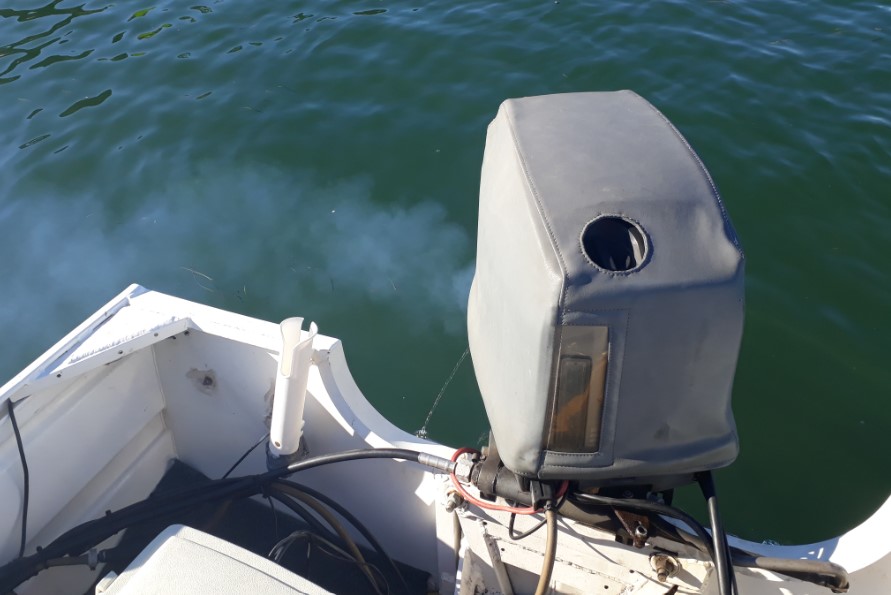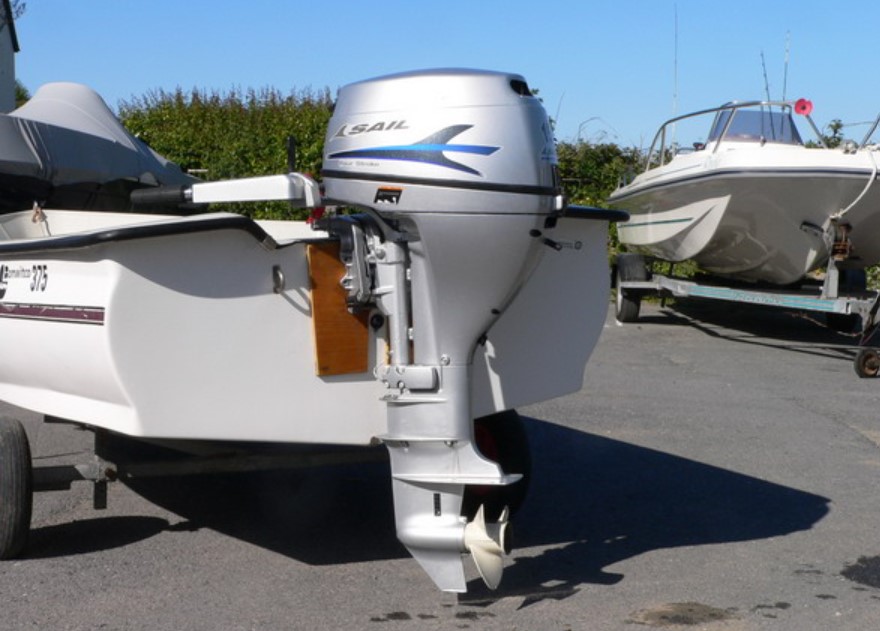How To Reduce Smoke In 2 Stroke Outboard Engine? 10 Steps
Are you looking for How To Reduce Smoke In 2 Stroke Outboard Engine? In the quest to reduce smoke in 2-stroke outboard engines, understanding the mechanics behind smoke production is essential.
Typically, smoke is caused by incomplete combustion, often due to a mixture of fuel and oil that’s too rich or poor engine tuning. Addressing these issues can significantly decrease smoke emissions, leading to a more efficient and environmentally friendly operation of your outboard engine.
Key Takeaways
- Regular maintenance is crucial for reducing smoke.
- Use the correct fuel-to-oil ratio.
- Ensure proper engine tuning.
- Regularly replace the spark plugs and air filter.
- Consider using synthetic oils for better combustion.
How To Reduce Smoke In 2 Stroke Outboard Engine?
Reducing smoke in a 2-stroke outboard engine is crucial for both environmental health and the longevity of the engine. Here are detailed steps to achieve this:

1. Correct Fuel-to-Oil Ratio
- Understanding the Ratio: The fuel-to-oil ratio is critical in 2-stroke engines. This ratio can vary, but common ratios include 50:1 or 40:1, meaning 50 or 40 parts of fuel to 1 part of oil.
- Measuring Accurately: Use a measuring container to mix the fuel and oil accurately. Do not estimate, as even small deviations can impact smoke production.
- Consulting the Manual: Always refer to the engine’s manual for the manufacturer’s recommended ratio.
2. Use High-Quality Oil
- Selecting the Right Oil: Choose high-quality, 2-stroke specific oil, preferably synthetic, as it burns cleaner than standard oil.
- Avoiding Cheap Alternatives: Lower-quality oils can lead to incomplete combustion, thus increasing smoke production.
3. Regular Engine Maintenance
- Cleaning the Carburetor: Ensure the carburetor is clean and adjusted correctly to prevent fuel-rich mixtures.
- Replacing Spark Plugs: Worn or dirty spark plugs can lead to inefficient burning. Replace them according to the schedule in the engine’s manual.
- Checking the Air Filter: A clean air filter ensures proper airflow for combustion. Replace or clean it regularly.
4. Engine Tuning
- Adjusting Carburetor Settings: This ensures the correct mixture of air and fuel, which is essential for efficient combustion.
- Timing Adjustments: Proper ignition timing is crucial for efficient fuel burning and reducing smoke.
5. Using Fuel Additives
- Choosing Additives: Use additives designed for 2-stroke engines. These can clean the engine’s internals and improve combustion efficiency.
- Following Instructions: Use additives as directed, usually by mixing with the fuel.
6. Regular Inspection and Repairs
- Inspecting for Wear and Tear: Regularly check for any signs of wear or damage, especially to the piston rings and cylinder.
- Seeking Professional Help: If unsure about any issues, consult a professional mechanic.
7. Proper Storage Techniques
- Winterization: If the engine will be idle for extended periods, follow proper winterization procedures to prevent fuel degradation and oil sedimentation.
- Avoiding Moisture: Store in a dry place to prevent rust and corrosion.
8. Environmentally Friendly Practices
- Eco-friendly Oils: Consider using biodegradable 2-stroke oils.
- Responsible Disposal: Dispose of old fuel and oil responsibly.
9. Checking Exhaust System
- Inspecting for Blockages: Ensure the exhaust system is clear of any blockages or damages.
- Regular Cleaning: Keep the exhaust ports clean to ensure unobstructed gas flow.
10. Upgrading Engine Parts
- Considering Upgrades: In some cases, upgrading parts like the exhaust system can improve efficiency and reduce smoke.
- Consulting Experts: Make upgrades based on professional recommendations and in compliance with environmental regulations.
By following these steps meticulously, you can effectively reduce smoke in your 2-stroke outboard engine, contributing to a cleaner environment and ensuring the longevity of your engine.
Understanding Smoke in 2 Stroke Outboard Engines
Causes of Smoke
Excessive smoke in 2-stroke outboard engines usually arises from an imbalance in the fuel-to-oil ratio or poor combustion. It’s crucial to grasp the mechanics behind this to effectively tackle the problem. A rich fuel mixture, old or low-quality oil, and inefficient combustion due to worn parts can contribute to this issue.
Impact of Smoke
Apart from being an environmental concern, excessive smoke can hint at underlying engine issues. It often leads to reduced efficiency, potential engine damage, and increased maintenance costs. Understanding these impacts helps in prioritizing the need for smoke reduction.
Optimizing Fuel-to-Oil Ratio

Importance of Correct Ratio
The fuel-to-oil ratio in a 2-stroke engine is a delicate balance. Too much oil can lead to excessive smoke and residue, while too little can cause engine damage. Using the manufacturer’s recommended ratio is vital for optimal performance and smoke reduction.
Calculating the Ratio
Understanding how to calculate the correct fuel-to-oil ratio is fundamental. This usually involves mixing a specific amount of oil per gallon of gasoline, as specified by the engine’s manufacturer. Adhering to these guidelines ensures the engine runs smoothly with minimal smoke.
Regular Maintenance for Smoke Reduction
Engine Tuning
Regular engine tuning is paramount. It involves adjusting the carburetor and ensuring the ignition system functions correctly. Proper tuning optimizes fuel combustion, thereby reducing smoke.
Spark Plug and Air Filter Replacement
Replacing spark plugs and air filters at recommended intervals is crucial. Worn spark plugs or clogged air filters lead to inefficient combustion and increased smoke. Regular replacements ensure the engine burns fuel more cleanly.
The Role of High-Quality Oil
Benefits of Synthetic Oils
Synthetic oils are often recommended for 2-stroke engines. They burn cleaner than conventional oils, reducing smoke and improving engine performance. Though slightly more expensive, the benefits they offer in reducing smoke and protecting the engine are substantial.
Oil Selection Tips
Choosing the right oil involves looking at viscosity, manufacturer recommendations, and performance standards. High-quality oils not only reduce smoke but also extend the engine’s lifespan.
Advanced Techniques for Smoke Reduction

Engine Modifications
In some cases, modifications to the engine, such as upgrading the exhaust system or using advanced air intake systems, can significantly reduce smoke. However, these should be done by professionals and in line with environmental regulations.
Use of Additives
Fuel additives designed for 2-stroke engines can help in reducing smoke. These additives aid in cleaner combustion and can clean existing residue within the engine, improving overall performance.
Why Is My 2 Stroke Outboard Smoking So Much?
Excessive smoke from a 2-stroke outboard engine can be attributed to several factors. The most common reason is an incorrect fuel-to-oil ratio.
If the mixture contains too much oil, it leads to excessive smoke as the extra oil burns off. Another cause could be the use of poor-quality oil or old, degraded fuel, which does not combust efficiently.
Engine problems such as worn piston rings, a dirty carburetor, or a malfunctioning ignition system can also lead to increased smoke, as they prevent the engine from burning fuel cleanly. It’s vital to address these issues promptly to prevent further engine damage and to reduce environmental impact.
How Do You Make A 2 Stroke Not Smoke?
Reducing smoke in a 2-stroke engine involves several key steps. First, ensure the fuel-to-oil ratio is correct according to the manufacturer’s specifications. Use high-quality 2-stroke oil, which is designed to burn cleanly and efficiently.

Regular maintenance, including cleaning the carburetor, replacing the air filter, and checking the spark plugs, is crucial. Tuning the engine to ensure proper ignition timing and fuel mixture can also greatly reduce smoke.
Finally, consider using fuel additives designed for 2-stroke engines, as they can clean the internal components and improve combustion efficiency.
What 2 Stroke Outboard Oil Smokes The Least?
Synthetic 2-stroke oils are generally known to produce the least amount of smoke. These oils are specifically formulated to provide better lubrication, cleaner burning, and more efficient operation of 2-stroke engines.
Brands like Yamalube, Evinrude/Johnson, and Mercury Premium Plus have been consistently recommended by experts for their high performance and low-smoke properties.
When selecting an oil, it’s important to look for ones that are NMMA certified (TC-W3 standard), as these have been tested for performance in 2-stroke marine engines. Using the right oil not only reduces smoke but also helps extend the life of the engine.
Conclusion
Reducing smoke in a 2-stroke outboard engine is not just about environmental responsibility; it’s also about maintaining the engine’s efficiency and longevity.
By understanding the causes of smoke, optimizing the fuel-to-oil ratio, ensuring regular maintenance, using high-quality oils, and considering advanced techniques, one can significantly reduce smoke emissions.
Implementing these strategies will not only enhance the performance of your outboard engine but also contribute to a cleaner environment. Remember, a well-maintained engine is a less smoky one, and this proactive approach can save you from future costs and complications.
People Also Ask
Can incorrect storage of a 2-stroke outboard engine lead to increased smoke?
Yes. Improper storage, especially over the winter, can lead to issues like fuel degradation and oil sedimentation. These can cause the engine to produce more smoke when started again. Proper winterization and storage techniques are key to reducing smoke.
How does the age of a 2-stroke outboard engine affect smoke production?
Older engines tend to produce more smoke due to wear and tear on engine components. Regular maintenance becomes increasingly important as an engine age to keep smoke production to a minimum.
Is it necessary to use fuel additives in 2-stroke outboard engines?
While not always necessary, fuel additives can be beneficial. They are designed to clean the engine and fuel system, leading to better combustion and reduced smoke. However, it’s essential to use additives specifically designed for 2-stroke engines.
Can a dirty air filter cause increased smoke in a 2-stroke engine?
Yes, a dirty air filter can lead to increased smoke. A clogged air filter restricts airflow to the engine, disrupting the optimal air-fuel mixture. This can cause incomplete combustion, leading to higher smoke emissions.

Welcome to the exhilarating world of Matt Rex, a professional car racer turned renowned vehicle enthusiast. Immerse yourself in his captivating blog as he shares heart-pounding adventures, expert reviews, and valuable insights on cars, trucks, jets, and more. Fuel your passion for speed and discover the beauty of vehicles through Matt’s engaging stories and meticulous expertise. Join the ever-growing community of enthusiasts who find inspiration and expert advice in Matt Rex’s blog—a digital hub where the thrill of speed meets the pursuit of knowledge.



![Nissan Connect Keeps Restarting [How To Fix This?]](https://www.turbochaos.com/wp-content/uploads/2024/01/Nissan-Connect-Keeps-Restarting-768x708.jpg)

![Yamaha SUV 1200 4-Stroke Conversion [Explanation]](https://www.turbochaos.com/wp-content/uploads/2023/08/Yamaha-SUV-1200-4-Stroke-Conversion-768x512.jpg)

